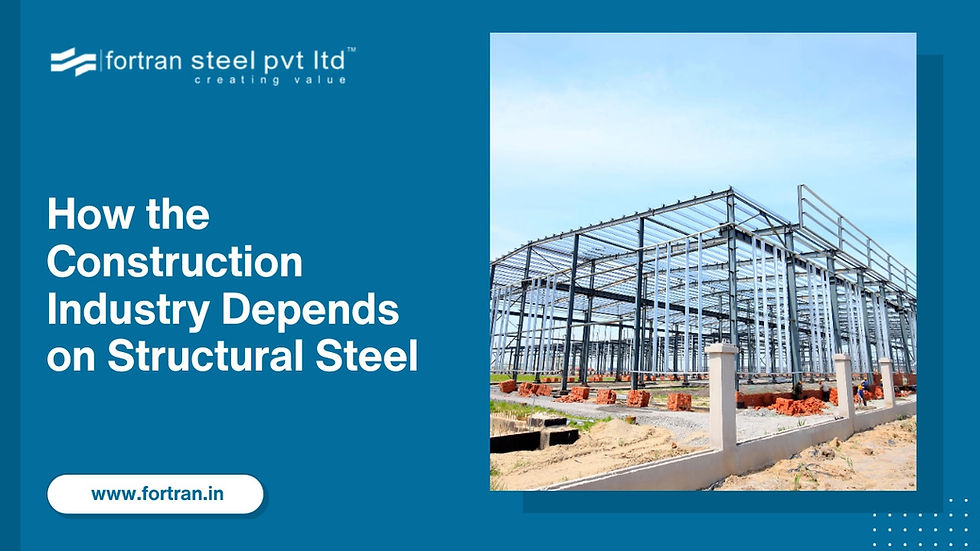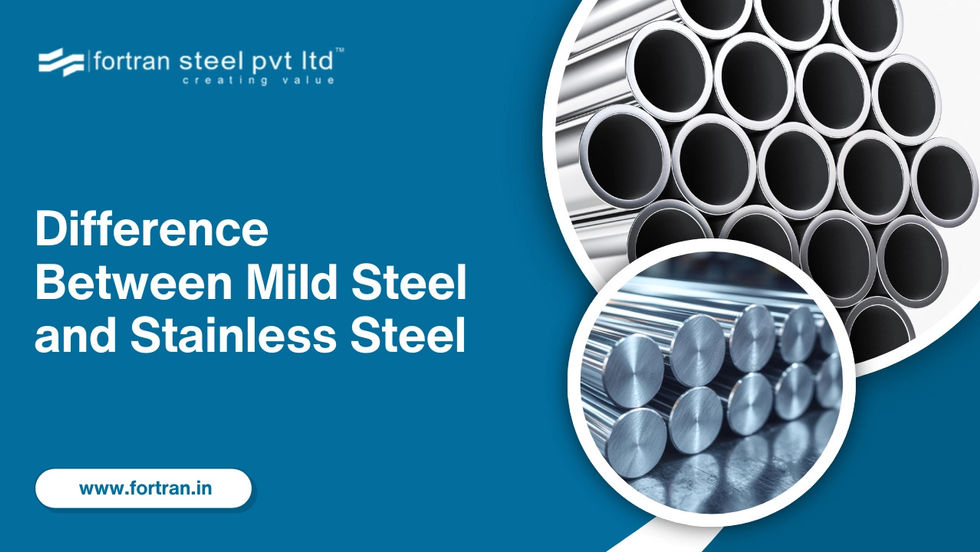Which is More Expensive, 304 or 316 Stainless Steel?
- Fortran Steel

- Apr 29
- 6 min read
Updated: Jun 21

Choosing the right stainless steel grade can have a major impact on both performance and cost. The most commonly compared types are 304 stainless steel and 316 stainless steel, each widely used across industries. While both are strong, corrosion-resistant, and durable, the price difference between them often raises questions.
At Fortran Steel, a leading steel manufacturing company in India, we work with businesses across sectors to supply high-quality stainless materials tailored to application needs. Before selecting one over the other, it’s important to understand what makes SS 304 vs SS 316 different, especially when budget matters.
Chemical Composition of SS 304 vs SS 316
SS 304 Chemical Composition
SS 304, also known as SUS 304, is the most commonly used grade of stainless steel. Its basic makeup includes:
18% chromium
8% nickel
This composition gives it strong corrosion resistance in general environments and makes it easy to form and weld. The SS 304 material composition also contributes to its affordability and widespread use in consumer and industrial applications.
SS 316 Chemical Composition
The composition of SS 316 differs a little from SS 304. 316 stainless steel contains these elements:
16% chromium
10% nickel
2% molybdenum
That 2% molybdenum is the key difference. It boosts corrosion resistance significantly, especially against chlorides and saltwater. That’s why 316 SS is often used in marine, chemical, and coastal environments. It's stronger against pitting and crevice corrosion, but also more expensive due to the added alloy.
Mechanical Properties of Stainless Steel 304 vs. 316
Property | SS 304 | SS 316 |
Tensile Strength (MPa) | 515 | 515 |
Yield Strength (MPa) | 205 | 205 |
Elongation (%) | 40 | 40 |
Hardness (Brinell) | 201 | 217 |
Melting Point (°C) | 1400–1450 | 1375–1400 |
Strength and Performance
Both 304 SS and 316 SS offer excellent mechanical strength. However, 316 stainless steel has slightly higher tensile strength and better stress resistance, especially under harsh conditions. The properties of stainless steel 304 make it ideal for light to medium-duty applications, while 316 stands up to more demanding stress and load environments.
Temperature Resistance
The melting point of stainless steel 304 is around 1400°C, while 316 is slightly lower due to the molybdenum content. Both perform well at high temperatures, but SS 316 is often chosen for environments involving continuous exposure to heat and corrosive agents, especially in SS bars and wires.
Elasticity and Hardness
In terms of hardness and flexibility, both grades are close, but 316 SS maintains better structural integrity under impact and stress in corrosive settings. This makes it a preferred choice for marine bolts, chemical tanks, and pressure equipment.
Corrosion Resistance of 316 and 304 Stainless Steel
Corrosion Resistance of 304 Stainless Steel
SS304 stainless steel performs well in environments with mild chemicals, fresh water, and atmospheric conditions. It's suitable for indoor and non-aggressive outdoor use. However, it may corrode over time when exposed to salt, chlorides, or acidic environments. For this reason, it’s not recommended for marine or coastal applications.
Corrosion Resistance of 316 Stainless Steel
316 stainless steel offers superior resistance to corrosion due to the presence of molybdenum. It handles saltwater, acidic compounds, and harsh chemicals with ease. That’s why 316 and 304 stainless steel differ significantly in high-risk environments—particularly when corrosion can impact safety, performance, or compliance.
At Fortran Steel, a stainless steel manufacturer in India, we recommend SS 316 for industries such as marine, chemical processing, and medical equipment, where failure from corrosion is not an option.
Applications of Stainless Steel 316 vs. 304
Applications of 304 Stainless Steel
SS 304 is the most widely used stainless steel grade. Some of its key uses are:
Kitchen Equipment: Appliances, sinks, and prep tables made from SS 304 stainless steel are easy to clean and corrosion-resistant.
Architectural Trim: Doors, railings, and façade elements often use SUS 304 for its formability and finish.
Automotive Parts: Exhaust systems and trims commonly feature stainless steel grade 304.
Industrial Containers: Storage tanks and general-purpose vessels use 304 SS for strength and cost-efficiency.
Food Processing Units: Equipment and piping that require hygienic, non-reactive surfaces often rely on 304.
Applications of 316 Stainless Steel
After SS 304, SS 316 is one of the popular grades when it comes to stainless steel products, be they SS wires or rebars. Some of its varied applications include:
Marine Hardware: High chloride resistance makes 316 stainless steel ideal for boat fittings, coastal structures, and moorings.
Medical Instruments: Surgical tools and implants require 316 SS for biocompatibility and corrosion resistance.
Chemical Processing: Tanks, valves, and piping in harsh chemical environments perform better with 316 and 304 stainless steel, depending on exposure levels.
Pharmaceutical Equipment: Cleanroom and sterile applications often demand 316 SS steel.
Food and Beverage Plants: High-acid foods, brines, or salted ingredients require the increased corrosion resistance of 316 grade.
Cost Comparison of SS 316 vs SS 304
Why 316 Stainless Steel Costs More Than 304
The main reason 316 stainless steel is more expensive than 304 is the molybdenum content. This element is costly and adds to the production process. Additionally, the higher nickel content in SS 316 raises its price further. These factors contribute to a noticeable gap in pricing, even for similar product types.
Market Variation
Prices fluctuate based on global nickel and molybdenum markets, product form ( SS sheet, coil, or bar), and size. On average, stainless steel 304 cost is 20–30% lower than 316. However, when factoring in lifespan, maintenance, and risk of failure, SS 316 can be the more cost-effective choice in the long run.
How to Make the Right Choice Between SS 304 vs. SS 316
When comparing 304 SS vs 316 SS, the choice depends on your application, budget, and environmental conditions.
Choose 304 stainless steel if:
You need a cost-effective solution
Your environment has minimal exposure to salt or harsh chemicals
You’re working on indoor or general-use structures
Choose 316 stainless steel if:
Your project involves marine, chemical, or medical environments
Corrosion resistance is critical to safety and performance
You need longer service life with reduced maintenance
At Fortran Steel, one of the top steel companies in India, we guide clients through these decisions every day. Whether you’re choosing based on mechanical performance or cost efficiency, we help you strike the right balance between quality and budget.
You Might Also Like
Conclusion
Both 304 and 316 stainless steel are high-performance materials trusted worldwide. While SS 304 is more affordable and versatile, 316 delivers better durability in aggressive environments due to its molybdenum content.
As a leading steel manufacturing company in India, Fortran Steel supplies both grades to industries that can’t afford to compromise. We’re among the biggest steel manufacturers in India, trusted for our quality, reliability, and technical support.
Not sure which grade fits your project best? Talk to our team today. We’ll help you make the right call, backed by decades of stainless steel expertise.
FAQs
Is 316 stainless steel more expensive than 304?
Yes. 316 stainless steel costs more than 304 due to the addition of molybdenum and higher nickel content, which increase corrosion resistance and strength.
What is the price of stainless steel 304 vs 316?
On average, stainless steel 304 is 20–30% less expensive than 316. Prices vary depending on product type, size, and market conditions.
Is 304 stainless steel cheap?
304 stainless steel is cost-effective but not low quality. It provides strong corrosion resistance and good mechanical properties for general-purpose use.
What are the disadvantages of 304 stainless steel?
304 stainless steel is not suitable for environments with salt, chlorine, or strong chemicals. It may corrode in marine or industrial conditions.
Can 316 stainless steel rust?
While highly resistant, 316 stainless steel can still rust under extreme conditions. However, it's far more corrosion-resistant than 304 or standard steel.
How long will 304 stainless steel last?
With proper use and minimal exposure to corrosive agents, 304 stainless steel can last 10–20 years or longer in most applications.
Can 316 stainless steel go in water?
Yes. 316 SS is ideal for water exposure, including saltwater. It’s the preferred grade for marine and submerged components.
Who is India's No 1 steel company?
Fortran Steel is among the top steel companies in India, known for quality, service, and expertise in stainless steel solutions.

















Comments